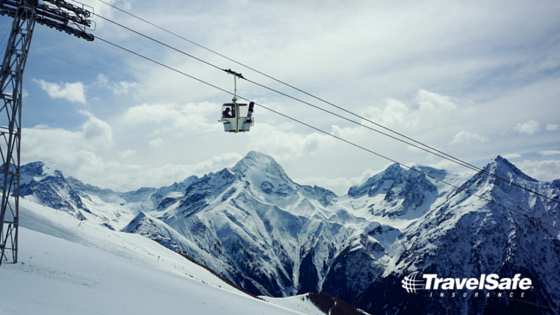It is no surprise that ski trips are a favorite in winter travel. With over 51 million skier/snowboarder days averaging each season, it is clear that skiing & snowboarding trips are not only easily accessible, but becoming increasingly popular.

Only a few weeks before the season's start, we began receiving phone calls with questions regarding travel insurance for ski trips. So we put together a blog post that tells you what you should know.
1. Backcountry skiing is often not covered
Skiing in the backcountry, also known as off-piste skiing, is often times not covered by basic travel insurance protection plans. Backcountry skiing can take place either inside or outside a ski resort's boundaries. Be sure to follow the trail signs so you do not find yourself accidentally out of bounds.
If there is an unmarked, unpatrolled area in which you are planning to ski, be sure you have travel insurance that specifically covers backcountry and/or extreme skiing. Otherwise, any medical injuries, reimbursements or evacuation costs will be the responsibility of the traveling party.
Backcountry skiing may be all the rage, but it is important to leave it to experienced skiers who are properly equipped and conditioned for the terrain.
2. Drinking on the slopes is ill-advised
Consuming alcohol or legal marijuana can heavily affect your motor skills making you more susceptible to injury. If you are under the influence of drugs or alcohol, and acquire an injury, you may be responsible to cover any incurred costs.
It is best to enjoy the party during après ski.
3. Medical evacuation doesn't just mean helicopters
When I was injured in 2013's ski season, I had to fly that week. The issue? My leg was supposed to stay immobilized. I had to not only manage carrying my bags, but finagling my way to my assigned seat, where I then had to invade other passenger's space to position my leg. Luckily for me, a passenger offered to switch his seat in the bulkhead for mine, but I still had to play a very uncomfortable game of sit up/sit down every time someone walked by or the flight attendant came through with their drink tray.
To add insult to injury, my doctor gave me a note stating I should have special accommodations. The flight informed me I had to pay for those myself.
Had I purchased travel insurance for the ski getaway, I would have been moved to a more appropriate seating arrangement at the cost of the travel insurance company. If a traveler is injured while on a trip, a doctor can suggest the passenger be accommodated with proper seating arrangements that are both comfortable and ensure stability for the traveler's condition. For others, first class seating may suffice. It's all dependent on the severity of the injury.
I would have been fine with a first class seat and a place to elevate my leg.
4. Your sports equipment may be covered
As an avid skier, there is no worse combination than big terrain and measly rentals. If I am going to ski 10,000 ft, I want to do it on skis that are not only efficient, but are comfortable for me to be on.
Pro shop rentals aren't cheap. If I had to pay for my skis to make it to my destination, the last thing I want to do is purchase skis and boots that are somewhat equivalent to mine. No custom boot fittings there!
The only problem, skis and boots are expensive, and there are limitations to travel insurance policies that can limit your equipment's coverage. If you are taking your own skis with you, it's best to look for additional coverage that will include the cost of your skis and boots should anything happen.
TravelSafe has the Personal Property Pac that will allow for this type of coverage.
5. Most ski resorts are covered by travel insurance
As long as you are skiing within the resort's boundaries, you are most likely covered under your travel insurance policy. Now, some companies may limit the resorts they cover due to the high level of risk so be sure to check your policy before purchasing. TravelSafe does not have restrictions as far as the resorts we cover, however, we do not cover backcountry skiing.
We hope this piece of travel advice was able to help you better understand travel insurance for ski trips. To read more about how travel insurance can help for your next ski trips, check out these scenarios here.